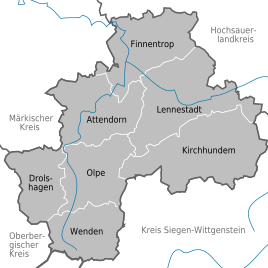Finnentrop (place)
|
Finnentrop
Finnentrop municipality
Coordinates: 51 ° 10 ′ 25 ″ N , 7 ° 57 ′ 59 ″ E
|
||
|---|---|---|
| Height : | 230-360 m | |
| Residents : | 3562 (December 31, 2016) | |
| Postal code : | 57413 | |
| Area code : | 02721 | |
|
Location of Finnentrop in the district of Olpe |
||
With around 3,500 inhabitants, Finnentrop is the largest district of the municipality of the same name, Finnentrop, in the Olpe district in North Rhine-Westphalia in the southern part of the Sauerland .
history

The name Finnentrop goes back to the old place Finnentrop, which is now called Altfinnentrop and is a few hundred meters up the Bigge. The ending “trop” is derived from “trop” or “torp” for “village” and is not uncommon in North Rhine-Westphalia (such as in Bottrop, Castrop, Frintrop or Waltrop). Today's Finnentrop had three place names until July 13, 1908: Habbecke , Neubrücke , and Finnentrop station (due to the construction of the Ruhr-Sieg Railway). Neubrücke consisted of only one building at the confluence of the Bigge and Lenne rivers ( Reuters House , first mentioned in 1847). The "New Bridge" was apparently already built in 1847 because the "Reuter" had to collect the bridge fee. The village of Habbecke further north, originally consisting of only a few courtyards, is likely to have emerged in the Middle Ages.
With the construction of the railway line into the Biggetal from 1870, the stop on the Ruhr-Sieg Railway, which opened in 1861, became the Finnentrop station . The operation of the line into the Biggetal from 1872 made it necessary to expand the facilities in Finnentrop: a separate track for rail traffic to Attendorn and Olpe with its own platform. In addition, a locomotive shed , workshops and special facilities ( turntable , pump house, water cranes , coaling plant , slag pit , etc.) were built.
The increased volume of traffic and the impending construction of the route through the Frettertal to Wennemen and Meschede required the construction of a new, much larger reception building. It was opened to traffic on April 1, 1900. The Finnentrop – Wennemen railway was opened on January 16, 1911. At the same time, a large expansion of the track system began. With this, the railway facilities reached their greatest extent. After the modernizations in the 1920s, the appearance changed little.
From the mid-1960s, the electrification of the line and its consequences, as well as the loss of importance of the railway for the transport system as a whole, made some of the systems superfluous, which then gradually disappeared.
Economy and Transport
Nationally known local companies include Metten Fleischwaren , Eibach Federn and ThyssenKrupp Steel AG . The Finnentroper Hütte was built in 1858 by the Neu-Oeger Mining and Hüttenverein. In 1863 additional blast furnaces were built. Initially, ore from the region was smelted later from the Wetzlar area. In 1885 the plant was converted from an OHG into a stock corporation. The capital came from 18 Siegerland shareholders. In 1900 the smelter became the property of the Westphalian steel works in Bochum . With 40 workers, it produced 13,000 tons of steel a year. Because production was unprofitable compared to the Ruhr area, iron and steel production was stopped in 1901. In the 1870s, the puddle and hammer mill of the Bonzel & Co. company with headquarters in Olpe was established . The operation went on in the company Wolf Netter & Jacobi . This was built around 1900, a thin sheet - rolling mill , which is also produced corrugated sheets. In 1938 Wolf Netter & Jacobi was " Aryanized " and taken over by the Mannesmann Group. As a result, the plant experienced a strong boom. Today the plant belongs to ThyssenKrupp Steel AG. In 1903, Metten Fleischwarenfabrik, today's largest company in the municipality, was founded.
Finnentrop by passing federal highway 236 , the finnentrop station developed in the course of construction of the Ruhr-win path 1858-1861.
Architectural monuments
Individual evidence
- ↑ Population statistics of the municipality of Finnentrop (as of December 31, 2016). (PDF) Municipality of Finnentrop, accessed on May 16, 2017 .
- ↑ Boris Brosowski: Basic features of industrialization in the southern Sauerland in the second half of the 19th century. Olpe, 1994, p. 52.
- ^ Franz Bitter: Finnentrop Sauerland. P. 67ff.
- ^ Peter Kracht: Sauerland, Siegerland and Wittgensteiner Land. Münster, 2005, p. 83.

